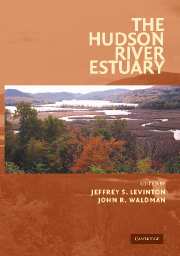Book contents
- Frontmatter
- Contents
- Preface
- List of Contributors
- The Hudson River Estuary
- 1 The Hudson River Estuary: Executive Summary
- GEOLOGICAL, PHYSICAL, AND CHEMICAL SETTING OF THE HUDSON
- 2 The Hudson River Valley: Geological History, Landforms, and Resources
- 3 The Physical Oceanography Processes in the Hudson River Estuary
- 4 Sedimentary Processes in the Hudson River Estuary
- 5 Benthic Habitat Mapping in the Hudson River Estuary
- 6 Reconstructing Sediment Chronologies in the Hudson River Estuary
- 7 Major Ion Geochemistry and Drinking Water Supply Issues in the Hudson River Basin
- PRIMARY PRODUCTION, MICROBIAL DYNAMICS, AND NUTRIENT DYNAMICS OF THE HUDSON
- HUDSON RIVER COMMUNITIES, FOOD WEBS, AND FISHERIES
- CONTAMINANTS AND MANAGEMENT ISSUES OF THE HUDSON RIVER ESTUARY
- Index
- Plate section
- References
3 - The Physical Oceanography Processes in the Hudson River Estuary
Published online by Cambridge University Press: 06 January 2010
- Frontmatter
- Contents
- Preface
- List of Contributors
- The Hudson River Estuary
- 1 The Hudson River Estuary: Executive Summary
- GEOLOGICAL, PHYSICAL, AND CHEMICAL SETTING OF THE HUDSON
- 2 The Hudson River Valley: Geological History, Landforms, and Resources
- 3 The Physical Oceanography Processes in the Hudson River Estuary
- 4 Sedimentary Processes in the Hudson River Estuary
- 5 Benthic Habitat Mapping in the Hudson River Estuary
- 6 Reconstructing Sediment Chronologies in the Hudson River Estuary
- 7 Major Ion Geochemistry and Drinking Water Supply Issues in the Hudson River Basin
- PRIMARY PRODUCTION, MICROBIAL DYNAMICS, AND NUTRIENT DYNAMICS OF THE HUDSON
- HUDSON RIVER COMMUNITIES, FOOD WEBS, AND FISHERIES
- CONTAMINANTS AND MANAGEMENT ISSUES OF THE HUDSON RIVER ESTUARY
- Index
- Plate section
- References
Summary
abstract The Hudson River has the attributes of a typical, partially mixed estuary – a moderate salinity gradient, significant vertical stratification, and a vigorous, two-layer circulation regime. Yet it also displays considerable variability, both in space and in time. In its northern reaches, the estuary becomes a tidal river, with no trace of oceanic salt but vigorous tidal currents. The salinity intrusion extends 100 kilometers (km) into the estuary during low discharge conditions, but it retreats to within 25 km of New York Harbor during the high river flows of the spring freshet. Fortnightly variations of tidal amplitude also result in pronounced variations in the estuarine regime, becoming well-mixed during strong spring tides and highly stratified during the weakest neaps. At the mouth of the Hudson is a complex network of tidal channels that link the estuarine regime of the Hudson to Long Island Sound, Newark Bay, and the Atlantic Ocean. The influence of the Hudson extends into the Mid-Atlantic Bight in the form of a low-salinity plume, which forms a coastal current and flows south along the New Jersey shore during favorable wind-forcing conditions.
Introduction
The Hudson River is one of the major watercourses of the United States East Coast. It originates on the slopes of Mt. Marcy in the Adirondack Mountains, extending nearly 600 km to New York City.
- Type
- Chapter
- Information
- The Hudson River Estuary , pp. 24 - 38Publisher: Cambridge University PressPrint publication year: 2006
References
- 24
- Cited by



